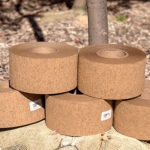You’ll never really know your profits for this year until you finish your replacements next year! Winter protection can help reduce these. Although we don’t mind selling you replacement plants, we do want your business to be as successful as possible
Three common practices we have covered in previous articles are applying Wilt Pruf on your broadleaf evergreens, putting up burlap screens as barriers to salt and wind, and using bark protectors to prevent deer and rabbit damage. There are two other recommendations I can give you.

Preventing frost cracks. Previous minor wounds, scuffs or scrapes on a tree trunk even when healed react differently to expansion and contraction from freezing and thawing repeatedly during the winter. The wood can split right open, sometimes with a sound like a rifle shot. This commonly happens on the sunny south or west side of the tree. One way to prevent this is to apply tree wrap each fall. This is a 4” wide waterproof, crinkled paper that you wrap around the trunks of young, thin-barked trees to protect from both sunscald and moisture loss. The death of the sap-carrying tissue from cracks or cankers can cause a surprising amount of damage higher up the tree. The tree wrap should be removed in the spring.

Provide adequate moisture. You may say “The plant has lost its leaves, why do I still need to water?” You may not realize that the optimum time for roots to grow is the fall season, right up until the ground freezes, which in some years is not until January. We often get rain this time of year but newly planted trees often need supplemental watering while they are replacing roots lost from being moved.
Even during winter months plant roots continue to replace moisture lost to drying winds and sun. Evergreens, both needled and broadleaved are particularly vulnerable. Plants that take up enough water will have the best chance to survive our winters and be ready for the spring push.

So water well, and mulch those beds to prevent desiccation during those below freezing weeks and hopefully your landscape jobs will look as good in the spring as they did when you installed them.

